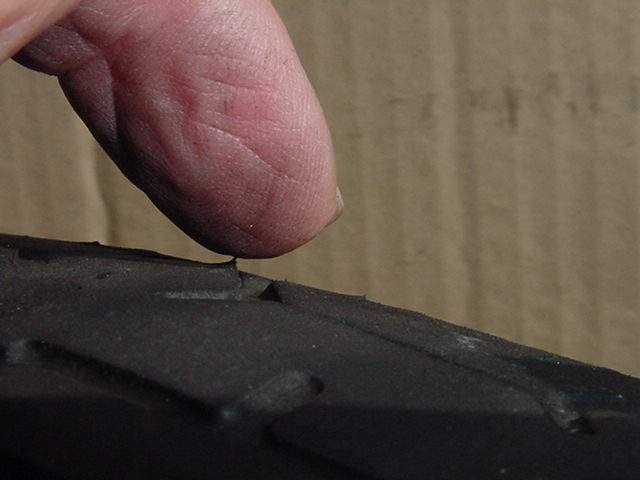Pretty good write up on what causes that "staggering effect" on front tire wear...
Motorcycle tire cupping and wear
By Duane Ausherman
Tire cupping, or scalloping, is usually considered a sign of some problem. The most blamed item is out of balance. Tire irregularities, loose steering head bearings, fork or frame alignment are also blamed. None of that is true by itself. This page applies to the front tire on solo bikes. Sidecar tires exhibit wear patterns, but nothing about a sidecar is symmetrical to start with and trends are harder for me to read.
Tire cupping is a sign of normal tire wear. Chris (Native) just up and did these fine drawings and emailed them to me. This is not the first time that he has fixed my poor art work. My thanks to Chris

This is supposed to be a side view of a typical front motorcycle tire under braking stresses. See how the breaks in the tread get bent back from the traction? The trailing edge at A collapses into the empty area that is between treads. That edge wears little because it isn't touching the road. Later on it shows up as a high spot.
The leading edge at B gets pulled back and wears off. This part of the tread block becomes a low spot.

This view is supposed to be a straight on view of a front motorcycle tire under stress from hard cornering. The spot A, the outside of the tread block, collapses into the empty space and doesn't wear down. The part at B takes most of the wear and shows up as "rounded off" later on.
This wear is normal for braking and leaning. If you do little of either then the wear will be far less. The softer the tire compound the greater is the distortion from wear of this nature. Racing tires that are really soft and sticky get worn out in a few hundred miles. Super hard road touring tires, gently ridden, can last 15 k miles.

A poor example of front tire wear. Sorry, but I haven't seen a better example when I had my camera in hand.
Reading motorcycle front tire tread wear
With this knowledge one can "read" a tire. More accurately, one can learn how the rider brakes and corners. Leaning over will leave a high spot on the outside (away from the center line of the tire) of the tread. Braking will leave a high spot at the rear of the tread, viewed as it touches the ground. If one corners and brakes at the same time, the outside rear will have the high spot.
From examining the wear pattern one can learn that the rider likes to lean one way more than the other. The rider will also brake harder while leaning one way more than the other. Compare the right side and left side wear. The more worn, the more that the rider is comfortable in that lean. Look at the rear of the tread block and see which side is more worn. That is the side that the rider is more comfortable using the brakes. Almost no rider is symmetrical in riding habits. It is common to find braking wear on one side and cornering wear on the other side. The rider brakes before going into a right hand turn and then goes through. On left hand turns the rider is willing to apply brakes while in the turn. Many combinations are possible.
This cupping wear pattern description applies to every tread block on the tire. Sometimes one will find significant cupping and every third or forth block is worn far more than the others. This is evidence of a wheel that is out of balance. Irregularly worn blocks are typical of an out of balance wheel. Really loose wheel bearings could also add to this odd wear.
Next time that you are around some motorcycles, try "reading" the tire wear. Tell the rider which side is what and watch the surprised look at your pronouncement.
The rear tire wear
The rear tire has quite different stresses on it and they are always more subtle and therefore harder to read. The rear has both braking and acceleration stresses. The wear from leaning is far less. Since the front tire is on the same bike as the rear tire, I use the front for my "readings" of rider habits.
What can be done about it?
1. A tire with a harder rubber compound will allow the tread to stay more rigid. That will not permit as much obvious cupping wear.
2. Consider a tread pattern that is more angular and not as straight or square.
3. Keep the inflation pressure up in the range that is specified by the manufacturer, or higher.
4. Don't corner as hard.
5. Don't brake as hard.
All of this is mostly useless, but fun at parties and such.
http://w6rec.com/duane/bmw/cupping/